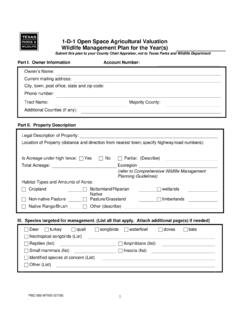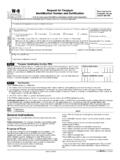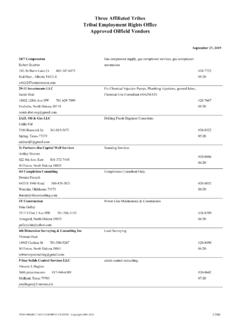Transcription of Food Plots for White-tailed Deer - Texas A&M University
1 food Plots for White-tailed deer Timothy E. Fulbright, Billy Lambert Wildlife Management Bulletin of the Caesar Kleberg Wildlife Research Institute Texas A&M University -Kingsville Management Bulletin No. 3. food Plots FOR White-tailed deer . Timothy E. Fulbright, Caesar KIeberg Wildlife Research Institute Mail Stop Center 218. Texas A&M University -Kingsville, Kingsville, Texas 78363-8202. Abstract: food Plots may increase the value of hunting leases, make deer more visible for viewing opportunities, and improve the diet quality of deer . However, planting food Plots is not a replace- ment for poor habitat management.
2 Maintaining deer densities within the carrying capacity of the habitat, sound livestock grazing management, and maintaining quality habitat should be the first priorities of any management program. Perennials do not require planting every year, but they produce less forage than annuals. All food Plots should be fenced from livestock and warm-season annual food Plots should be protected from deer until they are established. To improve diet quality, a ranch should have one cool-season and one warm-season food plot per square mile. plot size depends on the density of deer .
3 The size and number of Plots that can be established may be limited by lack of farmable soils. Rectangular-shaped Plots are preferred to long, narrow Plots . food Plots are the most productive if all woody plants inside the Plots are removed. When planting legumes, care should be taken to inoculate them properly. In semiarid habitats, skip row planting may increase plant survival and reduce seed costs. INTRODUCTION taining of an area in year-round agronomic food Plots increased body mass, number of antler Reasons for Planting food Plots points, beam circumferences, and beam lengths of Planting food Plots is one of the most widely White-tailed deer .
4 In Louisiana, yearling male white - used wildlife habitat improvement techniques. The tailed deer exhibited a 19% increase in live weights major reasons for planting deer food Plots include: following establishment of cool-season food Plots . (1) using Plots as a lease marketing strategy, (2) Much interest exists among landowners in increasing viewing and photographing opportunities, improving antler size of White-tailed deer . Genetic and (3) increasing the nutritional quality and quan- improvement of deer has received considerable tity of available forage.
5 Popular interest, but nutrition is more important in Presence of food Plots often represents the free-ranging deer . Good nutrition is essential to pro- landowner's commitment to deer management, duce large-bodied and large-antlered deer . Improv- which can aid the landowner in marketing lease prop- ing genetics through culling of inferior animals erty to prospective hunters. Billy Higganbotham, or introducing superior breed bucks will have little Texas A&M Wildlife Extension Specialist, estimated impact on free-ranging White-tailed deer populations that for each 1% of the land base planted in food on a practical time scale.
6 Even if genetic improve- Plots , the value of a hunting lease could be increased ment did impact free-ranging deer , habitat that pro- from $ to $ per acre. vides high levels of nutrition is needed for deer to A second reason to plant food Plots is to make express their genetic potential. deer more visible for viewing or photography. Many Unfortunately, nature does not consistently landowners, managers, and hunters derive satisfac- supply an optimally nutritious diet to deer . Nutri- tion from observing deer . Increased visibility also tional quality and availability of forbs (broad-leaved may benefit landowners involved in ecotourism, weeds) and browse (shrub leaves and twigs) fluctu- which is a growing industry.
7 Additionally, high vis- ate seasonally, limiting availability of natural foods ibility of deer feeding in food Plots can aid manag- at certain times of the year. ers in monitoring the body condition of deer , progress deer prefer forbs over browse and generally in antler growth, and other biological factors. consume little grass except when it is young, green, The third objective of planting food Plots is to and succulent. During rainy winters and springs, increase the quality and amount of forage available forbs often are abundant, resulting in deer that are to deer .
8 Researchers in Mississippi found that main- on a high nutritional plane. Most forbs grow best 165. during cooler periods and their abundance declines (5 1/2+ years old) should be harvested. The effect by May or June. Availability of forbs is limited dur- of food Plots or any form of supplemental feeding ing summer. Thus, late summer is often a period of on nutritional status, productivity, and quality of a nutritional stress for deer in the southeastern United deer herd will be reduced if one or more of the afore- States. Rains generally occur in late September and mentioned management priorities are ignored.
9 Only October in Texas . These rains stimulate plant growth when these priorities are accomplished should con- and improve the nutritional quality of deer diets dur- sideration be given to establishing food Plots . food ing the fall. As with other times of the year, rainfall Plots and supplemental feeding are not substitutes in September and October is sometimes lacking, for proper population and habitat management. resulting in poor forage conditions. Many people who promote supplemental feed- Although winter forbs are abundant if rainfall ing (pelleted feeds and food Plots ) advocate it as a is adequate, dry winters result in a lack of green, tool to increase deer densities beyond the carrying nutritious forbs.
10 Such winters may result in nutri- capacity of the habitat. Maintaining high deer den- tional stress for deer , particularly if a hard freeze sities at levels that threaten to degrade the habitat is occurs. Franz Vogt found that red deer stags had to dangerous, particularly in semiarid areas. Native be in a good nutritional state at least one month forages comprise a significant portion of deer diets before antler growth began to grow antlers of maxi- regardless of how much supplement is provided. mum size. If this is true for White-tailed deer in south High deer densities may be maintained in years with Texas , then February to May could be a particularly normal or above-average rainfall, but sooner or later critical time to have high-quality forage available a drought will occur.








